Content silos are a powerful strategy for organizing your website’s content to boost SEO performance. By creating clear, structured categories, you help search engines better understand your site while improving keyword targeting. This ultimate guide to content siloing explains how to use this technique to improve your website’s rankings, drive more organic traffic, and enhance the user experience. Explore expert tips, real-world examples, and actionable steps to elevate your silo SEO strategy today.
Table of Content
What Are Content Silos?
Content silos are a powerful website organization strategy that improves both user experience and search engine optimization (SEO). By grouping related pages into well-structured categories or themes, silos create a logical flow of information. This structure helps users easily navigate your site while signaling to search engines what your site is all about. The result? Better rankings, higher visibility, and a more user-friendly website.
How a Silo Structure Works?
Let’s say your website focuses on digital marketing. Here’s how you could create silos:
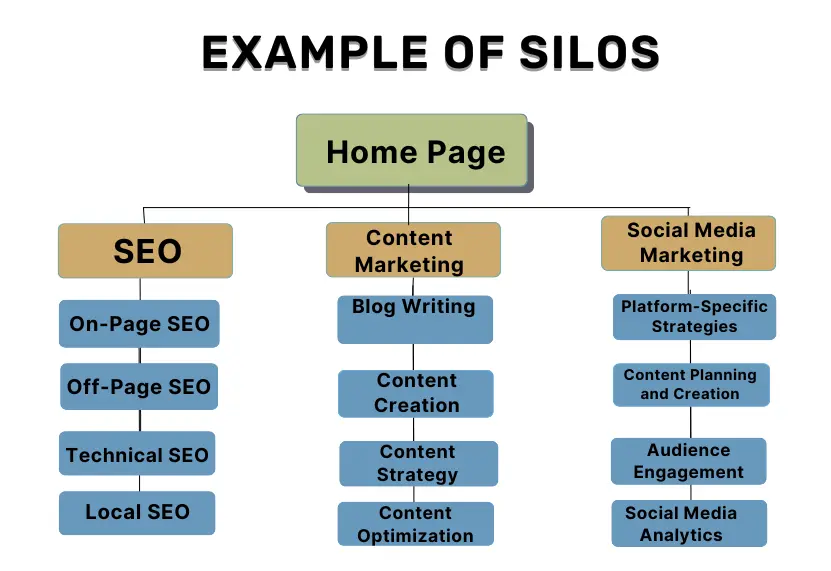
- SEO (Search Engine Optimization): Cover topics like on-page SEO, technical SEO, local SEO. These pages link to each other, forming a complete guide to mastering SEO.
- Content Marketing: Include topics like blog writing tips, content creation, content creation strategies, and measuring content performance. Each page dives deep into a subtopic but ties back to the broader content marketing silo.
- Social Media Marketing: Focus on platform-specific strategies (e.g., Instagram, TikTok, LinkedIn), audience engagement tips, and social media analytics. Add links to tools or guides to enhance usability and encourage further exploration.
By organizing your site into silos, you make it easier for search engines to index your pages and for visitors to find what they need. It’s a win-win for silo SEO and user experience.
Why Are Content Silos Important for SEO?
Content silos aren’t just about organization—they’re a game-changer for boosting your site’s rankings and driving targeted traffic. Here’s why they matter:
1. Better Keyword Targeting
Content silos help you target specific keywords and related search terms more effectively. For example, a “Fitness” silo could include pages optimized for keywords like strength training workouts, beginner workout plans, home cardio exercises, and HIIT workouts for fat loss. Each page focuses on a unique keyword while contributing to the overall silo, reducing keyword cannibalization and improving your chances of ranking for multiple searches.
2. Improved SEO and Crawlability
Search engines love websites that are well-organized. A silo structure creates a clear hierarchy and makes it easier for search engines to crawl your site. Internal links within each silo strengthen the connection between related pages, boosting your site’s relevance for specific topics. Plus, silos prevent orphan pages—isolated pages with no links—keeping your site optimized for search engines.
3. Establishes Topical Authority
A strong content silo positions your website as an authority in your niche. By covering a topic thoroughly, you demonstrate expertise and relevance to both users and search engines. For example, a “Healthy Eating” silo could include content on meal prep ideas, low-calorie recipes, nutrition tips, and healthy snack options. Providing in-depth, interconnected content builds credibility and trust, enhancing your rankings.
4. Enhances User Experience
Content siloing makes it easy for visitors to find information quickly. A clear structure improves navigation, keeps users engaged, and reduces bounce rates—all factors that boost SEO. For instance, a visitor reading about “technical SEO” in your SEO silo might be guided to related content like “common technical SEO mistakes” or “tools for SEO audits.” This creates a seamless experience that encourages users to stay longer on your site.
5. Aligns Content with User Intent
Silos help you organize your content around your audience’s needs. By grouping related topics, you can identify content gaps and create new pages to fill them. For example, if your “Social Media Marketing” silo is missing detailed content on Pinterest marketing, you can prioritize creating it. This ensures your site remains comprehensive, relevant, and helpful for users.
6. Boosts Internal Linking Opportunities
Silos naturally create internal linking opportunities that benefit users and search engines. Internal links improve site navigation, guide visitors to related content, and distribute link equity across your site. For example, linking “on-page SEO tips” to “technical SEO strategies” within the same silo strengthens the topic’s relevance and improves rankings for both pages.
How to Build Effective Content Silos for Better SEO
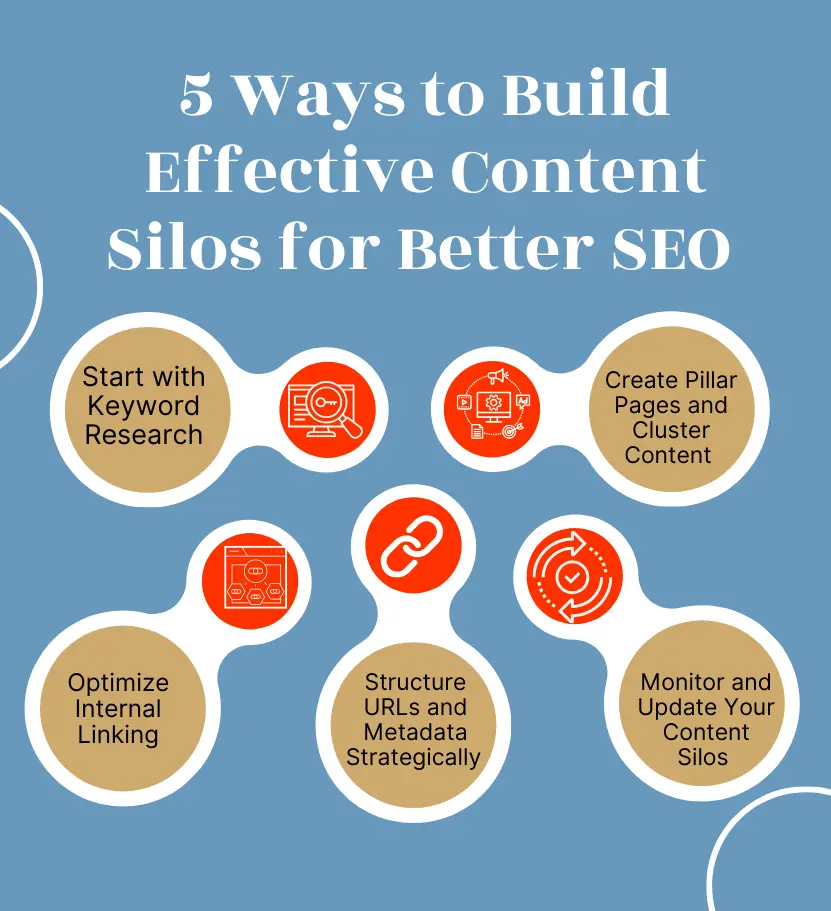
Creating content silos is one of the best ways to improve your website’s SEO, boost rankings, and enhance user experience. By organizing your content into silos, you make it easier for search engines and users to navigate your site, which can lead to higher engagement and conversions. Follow these steps to set up powerful content siloing that will maximize your silo SEO strategy.
1. Start with Keyword Research
Keyword research is the foundation of any successful content silo. Here’s how to do it effectively:
- Use tools like Google Keyword Planner, SEMrush, or Ahrefs to find high-value, relevant keywords for your niche.
- Group your keywords into broad topics or themes to serve as the basis for your silos. For example, if your niche is SEO services, your silos could be about SEO basics, content siloing, or advanced SEO strategies.
- Look for long-tail keywords that align with each theme to target more specific user queries. These will help you create highly targeted content within each silo.
2. Create Pillar Pages and Cluster Content
To structure your silos, you need a combination of pillar pages and supporting cluster content:
- Pillar Pages: These are comprehensive, in-depth pages that cover the main theme of the silo. For example, a pillar page titled “What Are Content Silos?” would offer a complete guide to silo structures and serve as the central hub for related content.
- Cluster Pages: These pages focus on subtopics related to the pillar page. For instance, under a silo about content siloing, you might have articles like “How Internal Links Improve SEO” or “Best Practices for Silo Structure.”
- Link all cluster pages back to the pillar page and vice versa. This creates a strong internal linking structure that helps search engines and users understand the relationships between topics.
3. Optimize Internal Linking for SEO
Internal linking is key to building a successful content silo. Here’s how to do it right:
- Link each cluster page to its corresponding pillar page using keyword-rich anchor text like “SEO silo strategies” or “content silo examples.”
- Include internal links between related cluster pages to strengthen the silo and improve user navigation.
- Keep your links relevant and natural to maintain a positive user experience.
4. Structure URLs and Metadata Strategically
Your website’s URL structure and metadata should reflect your content silos. Here’s what to keep in mind:
- Use clean, descriptive URLs that show the hierarchy of your silos. Examples:
- www.example.com/seo/content-silo
- www.example.com/social-media/strategy
- Write optimized meta titles and descriptions that include primary keywords for each page. For example:
- Use H1, H2, and H3 headers to structure your content and make it easy to skim. Include target keywords in your headers where appropriate.
- Write meta descriptions that are accurate, engaging, and keyword-rich to encourage clicks.
- Include primary and secondary keywords naturally throughout your content. Avoid keyword stuffing.
- Enhance user engagement with multimedia like images, videos, or infographics.
- Ensure your site is mobile-friendly and loads quickly to provide a seamless user experience.
5. Monitor and Update Your Content Silos
Building content silos isn’t a one-and-done task. Regular maintenance is critical to ensuring their effectiveness:
- Use tools like Google Analytics and Search Console to monitor silo performance. Track metrics such as organic traffic, bounce rates, and keyword rankings.
- Refresh outdated content with updated information and new insights to keep it relevant.
- Expand your silos by adding new cluster pages or creating new silos to target emerging keywords and trends in your industry.
Soft vs. Hard Silos: Choosing the Right Approach for Your Content

When organizing your website’s content, you can follow two primary siloing methods: soft silos and hard silos. Understanding their differences will help you select the approach that aligns best with your website’s objectives and strategy.
Soft Silos
Soft silos rely on internal linking to connect related pages without altering the physical structure of your site.
- Example: Imagine a blog where articles on “Silo SEO tips” are interlinked through hyperlinks, even if they don’t share the same category or URL structure.
Advantages:
- Simple to implement with minimal changes to your site’s existing setup.
- Highly flexible, allowing easy adjustments to links and topics as your content evolves.
Disadvantages:
- May not create as strong a keyword association as hard silos, potentially limiting SEO performance for competitive terms.
By understanding soft silos, you can determine whether their flexibility and ease of use align with your website’s goals or if a more structured hard silo approach is necessary.
Hard Silos
Hard silos organize website content through physical categorization, using structures like subdirectories, subdomains, or folder paths.
- Example: A site with URLs such as www.example.com/seo for SEO content and www.example.com/content-marketing for content marketing topics.
Advantages:
- Offers stronger keyword relevance and a well-defined, logical structure.
- Ideal for large websites with diverse categories.
Disadvantages:
- Demands significant technical effort, especially for established websites with existing structures.
Which Should You Choose?
Deciding between soft and hard silos depends on your website’s needs, goals, and available resources:
- Soft silos are perfect if you value simplicity and flexibility.
- Hard silos are better suited for enhancing SEO performance but may require more effort to implement structural changes.
Choose the approach that aligns with your objectives and capabilities!
The Drawbacks of SEO Siloing (and How to Fix Them)
SEO siloing is a powerful strategy to boost your website’s organization and search engine rankings. But when implemented incorrectly, it can create challenges that harm your site’s performance. Here are the most common drawbacks of content silos and tips to avoid them:
1. Content Isolation
Strict SEO silos can prevent important internal linking between related topics. This “content isolation” occurs when pages within a silo don’t share link equity or traffic with other silos. Isolated pages struggle to rank high in search results because they lack the internal links needed for search engine optimization. Proper internal linking is crucial to improve visibility and drive organic traffic.
2. Complex Maintenance
As websites grow, maintaining rigid silos becomes more complicated. Adding new content or updating existing pages can make the structure overly messy and difficult to manage. Without regular audits, outdated links and a confusing structure can hurt user experience and reduce SEO performance. For long-term success, keeping your silo structure up to date is essential.
3. Poor Navigation for Users
A rigid silo structure can make it harder for users to find related content outside their current silo. For example, someone reading about “SEO tools” in one silo might not easily discover a guide on “content marketing tools” located in another silo. This lack of cross-navigation can frustrate users, increase bounce rates, and lower user engagement—factors that negatively impact SEO rankings.
How to Avoid SEO Silo Mistakes
To maximize the benefits of SEO silos without the drawbacks:
- Use a flexible “soft silo” structure that balances organization and interlinking.
- Add contextual internal links between related pages across silos to improve navigation and distribute link equity.
- Regularly audit your website’s structure to ensure it remains intuitive and functional for both users and search engines.
By addressing these challenges, you can optimize your SEO strategy, enhance user experience, and achieve better rankings on search engine results pages (SERPs).
Why Choose Rankonix for Your Content Silo Strategy?
Looking to improve your website’s SEO and boost organic traffic? At Rankonix, we specialize in creating content silo strategies that help businesses rank higher on search engines and engage their audience effectively. Here’s why businesses trust us for their SEO needs:
- Custom Content Silo Creation: We conduct thorough keyword research and design content silos that improve website structure, drive traffic, and increase search engine rankings.
- Expert SEO Services: With years of experience in on-page SEO and content optimization, we ensure your website delivers value and relevance to both search engines and users.
- Comprehensive Website Optimization: From optimizing individual blog posts to enhancing your entire website’s SEO, we provide end-to-end solutions that boost visibility and audience engagement.
Contact Rankonix, the expert SEO agency, and see how our proven strategies can improve your online visibility and deliver real, measurable results.
Conclusion
Content silos are a powerful SEO strategy designed to improve website structure for both users and search engines. By organizing your content into clear, focused categories, creating high-quality pillar pages, and implementing effective internal linking, you can boost search engine rankings, enhance user experience, and establish topical authority. Success with content silos requires careful planning, regular updates, and balancing silo structure with cross-linking between related topics.
FAQs
Q. What is a content silo in SEO?
A content silo is an SEO strategy that organizes your website by grouping related content into categories. Each silo focuses on a specific topic, with a central pillar page linking to related subpages. This structure boosts SEO, improves navigation, and helps search engines understand your content better.
Q. What’s the difference between hard silos and soft silos?
Hard silos organize a website’s physical structure using subdirectories or category-based URLs (e.g., /seo/on-page-optimization). Soft silos use internal links to connect related content without changing the site’s structure. Both methods improve content organization for SEO and user experience.
Q. How do content silos improve search engine rankings?
Content silos help search engines understand the relationship between pages, improving indexing and boosting rankings. This structure enhances keyword targeting, improves crawlability, and keeps users engaged by providing relevant content—key factors for better visibility on SERPs.
Q. Can small websites benefit from content silos?
Yes, small websites can benefit from content silos. Start by grouping existing content into a few main categories based on your primary topics. As your site grows, expand the silos with more detailed subtopics to rank for both broad and specific keywords.
Q. Why are content silos important for SEO and user experience?
Content silos create a well-organized website that signals topical authority to search engines. They boost rankings, increase organic traffic, and make it easier for visitors to find what they need. A clear structure improves user engagement, lowers bounce rates, and encourages repeat visits, all key for long-term SEO success.
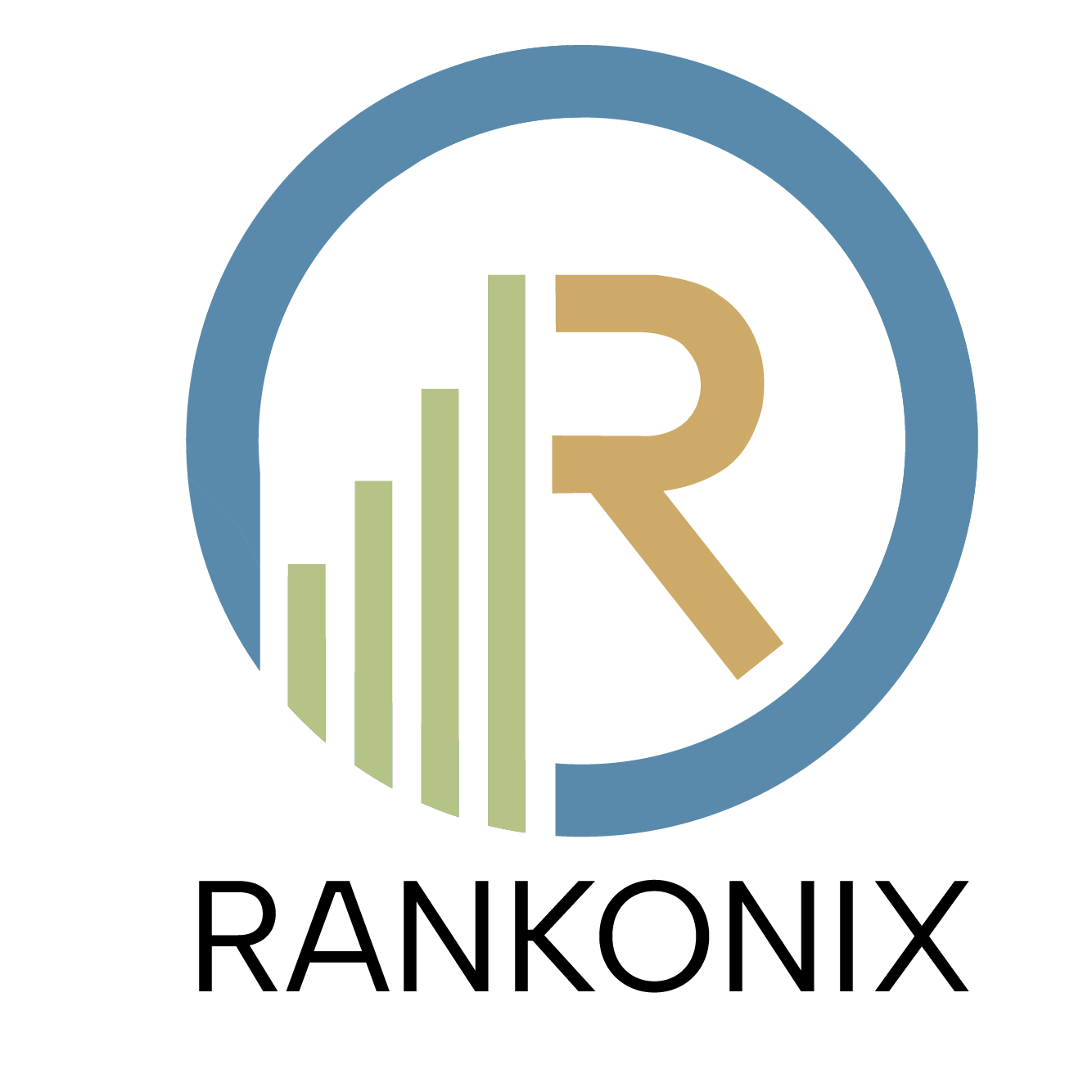
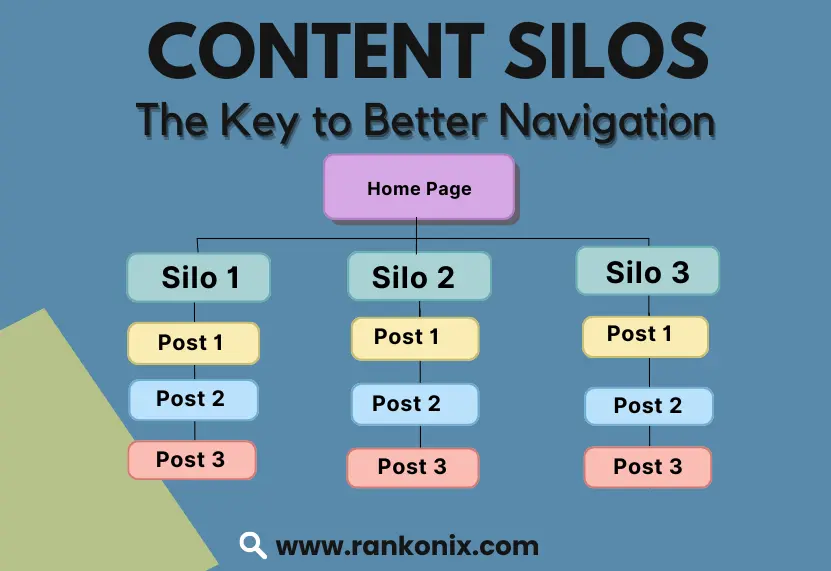
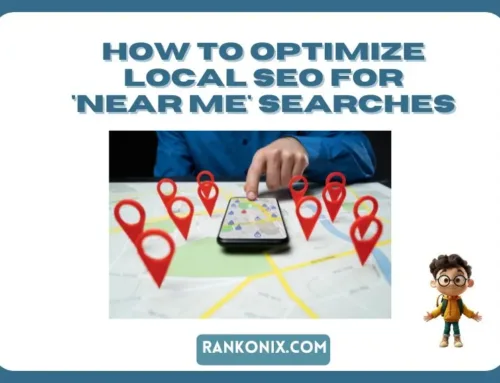







I am not sure where you’re getting your information, but great topic.
I needs to spend some time learning much more or understanding more.
Thanks for magnificent info I was looking for this
info for my mission.
We’re a group of volunteers and starting a new scheme in our
community. Your site offered us with valuable info to work on. You
have done an impressive job and our entire community
will be grateful to you.
Woah! I’m really digging the template/theme of this website.
It’s simple, yet effective. A lot of times it’s hard to get that “perfect balance” between superb usability and visual appeal.
I must say you’ve done a great job with this. Also, the blog loads extremely quick
forr me on Opera. Superb Blog!